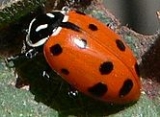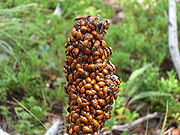
Convergent lady beetle
Encyclopedia

Hippodamia convergens, commonly known as the convergent lady beetle, is one of the most common lady beetles
Coccinellidae
Coccinellidae is a family of beetles, known variously as ladybirds , or ladybugs . Scientists increasingly prefer the names ladybird beetles or lady beetles as these insects are not true bugs...
in North America
North America
North America is a continent wholly within the Northern Hemisphere and almost wholly within the Western Hemisphere. It is also considered a northern subcontinent of the Americas...
and is found throughout the continent. Aphid
Aphid
Aphids, also known as plant lice and in Britain and the Commonwealth as greenflies, blackflies or whiteflies, are small sap sucking insects, and members of the superfamily Aphidoidea. Aphids are among the most destructive insect pests on cultivated plants in temperate regions...
s form their main diet and they are used for the biological control of these pests.
Life cycle
The female lady beetle lays 200 to 300 eggsEgg (biology)
An egg is an organic vessel in which an embryo first begins to develop. In most birds, reptiles, insects, molluscs, fish, and monotremes, an egg is the zygote, resulting from fertilization of the ovum, which is expelled from the body and permitted to develop outside the body until the developing...
over several months during spring and early summer. The eggs are small and spindle-shaped and are laid near the prey in upright batches of fifteen to thirty eggs. The larvae
Larva
A larva is a distinct juvenile form many animals undergo before metamorphosis into adults. Animals with indirect development such as insects, amphibians, or cnidarians typically have a larval phase of their life cycle...
are dark and somewhat alligator-shaped. Once the larvae begin feeding, they grow quickly and moult four times over a period of up to a month. The pupal
Pupa
A pupa is the life stage of some insects undergoing transformation. The pupal stage is found only in holometabolous insects, those that undergo a complete metamorphosis, going through four life stages; embryo, larva, pupa and imago...
stage lasts about a week and mating takes place soon afterwards. If there is an abundant supply of aphids the female may start laying within about a week of mating, but if the supply is scanty, she may wait for up to nine months.
Biology
The first larvae that hatch in each batch may start by eating the unhatched eggs. This may provide energy for the larvae before they find any aphids. Feeding takes place when a larva bites a hole in the body of an aphid and sucks out the juices. The lady beetle larva then pumps fluids back into the aphid body and sucks the fluid out again several times in order to extract the maximum amount of nutrition. The fourth-instarInstar
An instar is a developmental stage of arthropods, such as insects, between each molt , until sexual maturity is reached. Arthropods must shed the exoskeleton in order to grow or assume a new form. Differences between instars can often be seen in altered body proportions, colors, patterns, or...
larva may consume about fifty aphids per day and the adult lady beetle may eat about twenty. When aphids are scarce, the adults can eat honeydew
Honeydew (secretion)
Honeydew is a sugar-rich sticky liquid, secreted by aphids and some scale insects as they feed on plant sap. When their mouthpart penetrates the phloem, the sugary, high-pressure liquid is forced out of the gut's terminal opening. Honeydew is particularly common as a secretion in the Hemipteran...
, nectar and pollen
Pollen
Pollen is a fine to coarse powder containing the microgametophytes of seed plants, which produce the male gametes . Pollen grains have a hard coat that protects the sperm cells during the process of their movement from the stamens to the pistil of flowering plants or from the male cone to the...
or even petals and other soft parts of plants. However they must consume aphids in order to reproduce.
In the western United States, these beetles may spend up to nine months hibernating
Hibernation
Hibernation is a state of inactivity and metabolic depression in animals, characterized by lower body temperature, slower breathing, and lower metabolic rate. Hibernating animals conserve food, especially during winter when food supplies are limited, tapping energy reserves, body fat, at a slow rate...
in large aggregations in mountain valleys, far from their aphid food sources. In spring, the adults spread out and search for suitable sites to lay their eggs where aphids are plentiful. This dispersal trait is especially marked in this species as compared to other lady beetles.
External links
- http://www.nysaes.cornell.edu/ent/biocontrol/predators/hippodamia.html
- http://www.fcps.k12.va.us/StratfordLandingES/Ecology/mpages/convergent_ladybug_beetle.htm
- http://bss.sfsu.edu/holzman/courses/fall99projects/ladybug.htm

